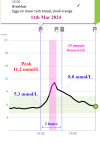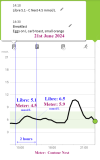You might find that
@Burylancs is in a minority on this forum in his attitude to the word 'reversing'
I was diagnosed in October with a HbA1c of 89 mmol/mol (very diabetic indeed). The repeat test result came in at 92. At the time I weighed around 101Kg, with a BMI of 34.5. I was put on Metformin (2000mg) and later Dapagliflozin (10mg) per day. Once I learned about the concept of remission and how it works I began trying to lose weight fast.
On January 24th I had another HbA1c test. By the day the blood was drawn I had lost around 12Kg. The result came back at 39 mmol/mol. The meds helped of course, but those meds can't possibly help that much. My GP said it was 'unprecedented', presumably because based on what he learned in medical school, tried-and-tested evidence-based medicine grounded in science from 20+ years ago, he may actually have thought such a drop as virtually unprecedented. It wasn't of course, I just Googled how to do it, read about it on websites like this one, and just did it. I understood that by late January I had reversed insulin resistance in my liver, leading to a huge drop in my fasting blood glucose levels, resulting in a huge drop in my HbA1c. 'Reversed' is a completely valid word to use in this context.
In March I used a Continuous Glucose Monitor (CGM), a Libre 2, took screenshots after meals, and later edited them to add some data points. I did the same thing again in June. These two screenshots show my blood glucose levels after eating nearly identical meals.
View attachment 30950View attachment 30951
These screenshots illustrate the effect of further weight loss, which reduces insulin resistance in adipose tissue somewhat (fat cells), and a (likely) partial recovery of my first-phase insulin response (from my pancreas).
In June I weighed around 72Kg, with a BMI just below 25, having lost around 28% of my body weight. A HbA1c test taken in June came back with a result of 32 mmol/mol. That's 10 points below the prediabetes range and 16 points below the threshold for a diabetes diagnosis. Bear in mind though that I was, and still am, on the meds. The second curve on the second graph, where I had Thai food delivered (with a big but not huge portion of noodles) illustrates that I am definitely not 'cured'. I had to go for a long walk to push my BG levels back down after that meal. The two slices of lower carb (50% reduced) bread I ate along with the little clementine orange might be nearly invisible on a CGM graph from a completely healthy person. I am still a diabetic and I'll never feast on pizza again.
To call this kind of improvement 'Good Control', a term that pre-dates the science that demonstrated how my HbA1c results and the difference between these two graphs is possible, is less than accurate. This kind of change was thought by most doctors to be impossible, ludicrous, up until around 2016. Some likely still believe it is impossible because they're not paying attention to recent science. 'Unprecedented', so long as you don't actually Google it. I would say that I have partially reversed my diabetes. I do not believe complete reversal is possible, there is no 'cure' for me, but to push progression of the disease backwards a fair bit through big weight loss is indeed possible. 'Reversal' is as good a word as any.
For some further information on how all this works, watch this long video interview with Prof Roy Taylor -
Link
Very best of luck!



